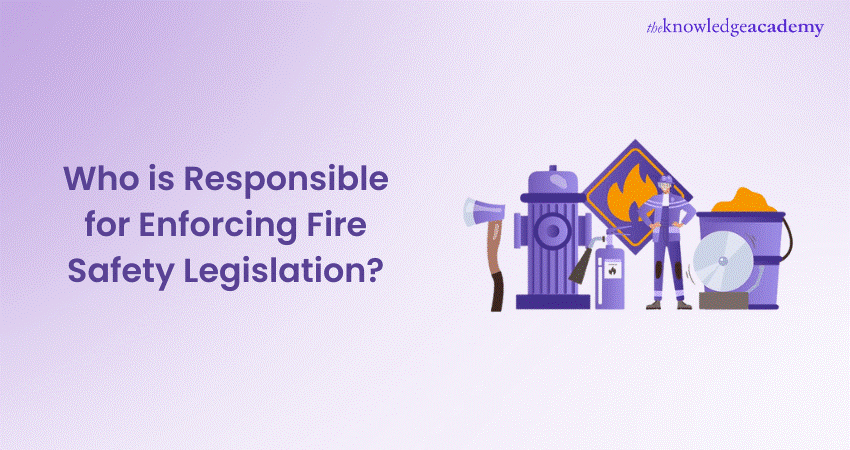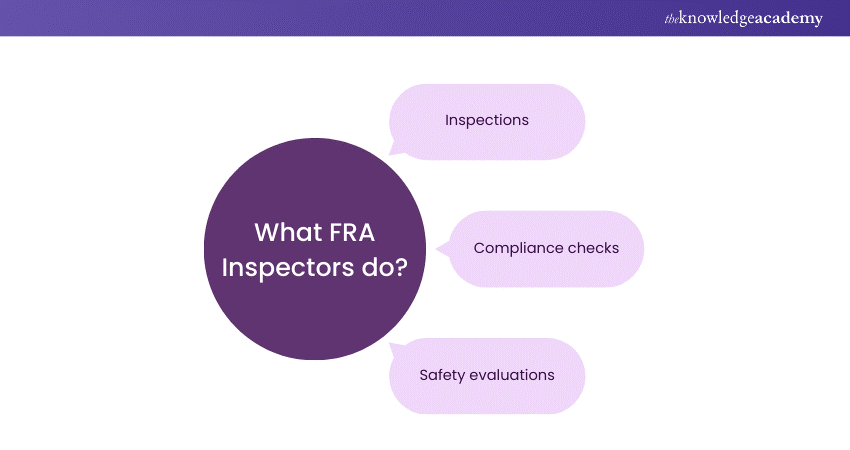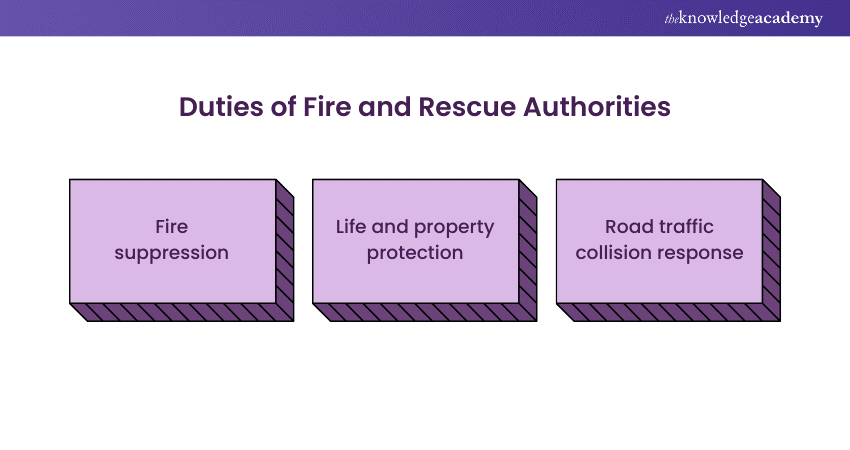We may not have the course you’re looking for. If you enquire or give us a call on +971 8000311193 and speak to our training experts, we may still be able to help with your training requirements.
Training Outcomes Within Your Budget!
We ensure quality, budget-alignment, and timely delivery by our expert instructors.

Fire Safety is a critical concern that affects us all. The devastating consequences of fire incidents are far-reaching, impacting lives, property, and communities. Yet, despite the awareness, gaps persist in enforcing Fire Safety regulations. Understanding Who is Responsible for Enforcing Fire Safety Legislation can help bridge these gaps and ensure greater safety for everyone.
This blog will explore Who is Responsible for Enforcing Fire Safety Legislation in the United Kingdom. We will shed light on the roles and responsibilities of key stakeholders in ensuring compliance and enhancing Fire Safety measures nationwide. Keep reading to learn more!
Table of Contents
1) Who is Responsible for Enforcing Fire Safety Legislation?
2) What is required of the person responsible?
3) How are Fire and Rescue Authorities tasked with enforcing Fire Safety Legislation?
4) What are the duties of an FRA Inspector?
5) Conclusion
Who is Responsible for Enforcing Fire Safety Legislation?
The new regulations are designed to enhance transparent collaboration among UK Fire Safety authorities, primarily enforced by the Fire and Rescue Authority (FRA) at the local level. If you're unsure where to find your FRA, you can reach out to your local fire service or check the National Fire Chief’s Council website for guidance.
FRA Inspectors are crucial in upholding Fire Safety laws within buildings. Here’s what they are authorised to do:

a) Inspections: Inspectors have the right to enter properties to identify the responsible parties and ensure their cooperation during the inspection process.
b) Compliance checks: They assess whether the necessary Fire Safety information is shared as per guidelines. This includes reviewing building plans, installation documents for Fire Safety systems, and maintenance records.
c) Safety evaluations: Inspectors collect material samples to test for safety or flammability. If any materials are found to be unsafe, such as metal cladding with unmodified polyethylene filler or certain reactive chemicals and gases noted in fire risk assessments, they have the authority to order that these materials be dismantled, destroyed, or subjected to further testing.
These steps are part of a broader effort to ensure that Fire Safety standards are met and maintained, safeguarding both property and lives.
What is required of the person responsible?
The Responsible Person plays a crucial role in ensuring that a thorough fire risk assessment is performed on the building annually, and that all staff are well-informed about Fire Safety procedures. If the building is not open to the public for more than four days a week, this assessment is still required every year.
Moreover, they must ensure there are enough fire extinguishers strategically placed in accessible locations throughout the building. It's recommended to have at least one extinguisher on each floor to effectively manage small fires.
Additionally, installing electrical circuit breakers in areas with electrical equipment is advisable to prevent any overheating issues. It's also important to place clear and visible warning signs near these areas to alert people and discourage any unnecessary contact.
Join now to transform your workplace into a safer environment with our Health & Safety in the Workplace Training!
Requirements for non-domestic premises
Non-domestic premises, which include settings like offices, hospitals, schools, transport terminals, and entertainment venues, are managed by individuals responsible for upholding Fire Safety standards around the clock. Their duties involve several preventive measures to ensure safety and compliance.
This includes keeping a sufficient number of fire extinguishers on hand, installing sprinkler systems, setting up smoke detectors, and preventing the build-up of combustible materials. All these actions are aimed at enhancing Fire Safety and reducing risk within these premises, ultimately protecting the well-being of everyone present as well as the property itself.
Obligations for shared premises
In shared settings like hotels, hostels, hospitals, nursing homes, and prisons, it's crucial to have a fire risk assessment done by someone skilled in spotting potential hazards. This assessment shapes a fire action plan that's not only comprehensive but also regularly reviewed and refreshed to match any changes in the environment or operations.
To ensure everyone's safety, these buildings must have clear escape routes that are easy to access, built with fire-resistant materials, and equipped with direct staircases to the ground floor. Additionally, a reliable smoke detection system with audible alarms is essential. These precautions are all about keeping residents safe and minimising any potential harm if a fire does occur, making sure that in a crisis, everyone knows where to go and can get there safely.
Sign up today to enhance your skills and ensure safety with our comprehensive Fire Marshal Training!
How are Fire and Rescue Authorities tasked with enforcing Fire Safety Legislation?
Fire and Rescue Authorities play a vital role in keeping our communities safe. Here's a closer look at the essential duties they perform:

1) Fire suppression: FRAs are quick to respond to fires within their jurisdiction, deploying skilled firefighting personnel and resources to control and extinguish fires, thereby protecting lives and property.
2) Life and property protection: In the event of a fire, the primary focus of FRAs is to save lives and minimise property damage. This includes conducting rescue operations and implementing effective firefighting strategies to reduce any harm.
3) Road traffic collision response: FRAs also respond to road traffic accidents, where they provide critical assistance to those involved. Their trained teams use specialised equipment to ensure the safety and protection of accident victims.
Additionally, FRAs take proactive steps in fire prevention by enforcing important regulations like the Fire Safety Order. This includes inspecting buildings to ensure they meet Fire Safety standards and that those responsible for the buildings have taken adequate measures to reduce fire risks. Through these actions, FRAs work tirelessly to enhance public safety, aiming to reduce both the occurrence and the impact of fires in their communities.
Empower yourself with vital skills to protect lives and property – sign up for our Fire Risk Assessment Training today!
What are the duties of an FRA Inspector?
Fire and Rescue Authority Inspectors hold key responsibilities to ensure public safety in regard to fire hazards:
a) Inspection of premises: FRA Inspectors meticulously assess premises to ensure they meet Fire Safety regulations. Their thorough checks help identify any potential risks or non-compliance issues.
b) Regulatory compliance check: Inspectors verify adherence to the Regulatory Fire Safety Order, ensuring that all Fire Safety measures are properly installed and fully operational.
c) Material sampling: Inspectors may take samples of materials used in the premises to evaluate their safety and flammability. This helps determine if the materials meet safety standards.
d) Enforcement actions: If materials are found to be unsafe, inspectors have the authority to order their destruction, dismantling, or further testing to reduce risks and ensure safety.
e) Record and plan review: Inspectors review records and fire risk assessment plans to check for compliance and suggest improvements.
Although inspections are usually scheduled in advance, inspectors can also make surprise visits. During these inspections, they rely on the cooperation of the Responsible Persons at the premises to ensure the process is smooth and to address any issues found promptly. This collaborative effort is vital in maintaining safety and preventing fire-related incidents.
Take the first step towards safeguarding your environment with our Fire Extinguisher Training – Click here to join now!
Conclusion
In conclusion, understanding Who is Responsible for Enforcing Fire Safety Legislation is paramount for ensuring compliance, mitigating fire risks, and safeguarding lives and property. By empowering Fire and Rescue Authorities with enforcement duties, these regulations play a crucial role in promoting Fire Safety and minimising potential hazards.
Ensure safety and compliance with our comprehensive Fire Safety Training. Join today to safeguard your environment!
Frequently Asked Questions

No, the Fire Service is not a local authority. While it operates within local areas, it is a distinct organisation responsible for firefighting, rescue operations, and fire prevention efforts, operating independently or as part of a broader emergency services framework.

Fire protection is primarily a local responsibility, managed by local fire departments or fire services within specific jurisdictions. However, there may be involvement from state and federal authorities in certain cases, such as wildfires or incidents involving critical infrastructure or federal property.

The Knowledge Academy takes global learning to new heights, offering over 30,000 online courses across 490+ locations in 220 countries. This expansive reach ensures accessibility and convenience for learners worldwide.
Alongside our diverse Online Course Catalogue, encompassing 17 major categories, we go the extra mile by providing a plethora of free educational Online Resources like News updates, Blogs, videos, webinars, and interview questions. Tailoring learning experiences further, professionals can maximise value with customisable Course Bundles of TKA.

The Knowledge Academy’s Knowledge Pass, a prepaid voucher, adds another layer of flexibility, allowing course bookings over a 12-month period. Join us on a journey where education knows no bounds.

The Knowledge Academy offers various Fire Safety Courses, including the Fire Warden Training, Fire Risk Assessment Training and Fire Safety Training. These courses cater to different skill levels, providing comprehensive insights into Fire Safety.
Our Health and Safety Blogs cover a range of topics related to Fire Safety, offering valuable resources, best practices, and industry insights. Whether you are a beginner or looking to advance your Fire Warden skills, The Knowledge Academy's diverse courses and informative blogs have got you covered.









 Top Rated Course
Top Rated Course




 If you wish to make any changes to your course, please
If you wish to make any changes to your course, please


